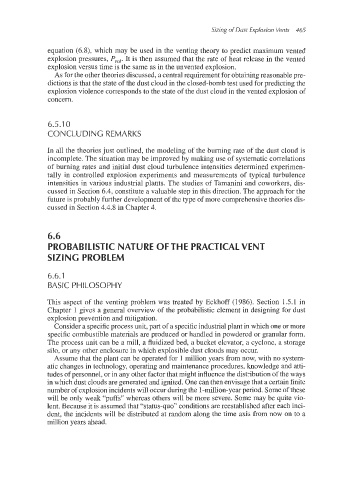Page 498 - Dust Explosions in the Process Industries
P. 498
Sizing of Dust Explosion Venfs 465
equation (6.8), which may be used in the venting theory to predict maximum vented
explosion pressures, Pred.It is then assumed that the rate of heat release in the vented
explosion versus time is the same as in the unvented explosion.
As for the other theories discussed, a centralrequirement for obtaining reasonable pre-
dictions is that the state of the dust cloud in the closed-bombtest used for predicting the
explosion violence corresponds to the state of the dust cloud in the vented explosion of
concern.
6.5.10
CONCLUDING REMARKS
In all the theories just outlined, the modeling of the burning rate of the dust cloud is
incomplete. The situation may be improved by making use of systematic correlations
of burning rates and initial dust cloud turbulence intensities determined experimen-
tally in controlled explosion experiments and measurements of typical turbulence
intensities in various industrial plants. The studies of Tamanini and coworkers, dis-
cussed in Section 6.4, constitute a valuable step in this direction. The approach for the
future is probably further development of the type of more comprehensivetheories dis-
cussed in Section 4.4.8 in Chapter 4.
6.6
PROBABILISTIC NATURE OF THE PRACTICAL VENT
SIZING PROBLEM
6.6.1
BASIC PHILOSOPHY
This aspect of the venting problem was treated by Eckhoff (1986). Section 1.5.1 in
Chapter 1 gives a general overview of the probabilistic element in designing for dust
explosion prevention and mitigation.
Considera specificprocess unit, part of a specificindustrialplant in which one or more
specific combustible materials are produced or handled in powdered or granular form.
The process unit can be a mill, a fluidized bed, a bucket elevator, a cyclone, a storage
silo, or any other enclosure in which explosible dust clouds may occur.
Assume that the plant can be operated for 1 million years from now, with no system-
atic changes in technology, operating and maintenance procedures, knowledge and atti-
tudes of personnel, or in any other factor that might influence the distribution of the ways
in which dust clouds are generated and ignited. One can then envisagethat a certain finite
number of explosionincidents will occur during the l-million-yearperiod. Some of these
will be only weak “puffs” whereas others will be more severe. Some may be quite vio-
lent. Because it is assumed that “status-q~o~~conditionsare reestablished after each inci-
dent, the incidents will be distributed at random along the time axis from now on to a
million years ahead.

